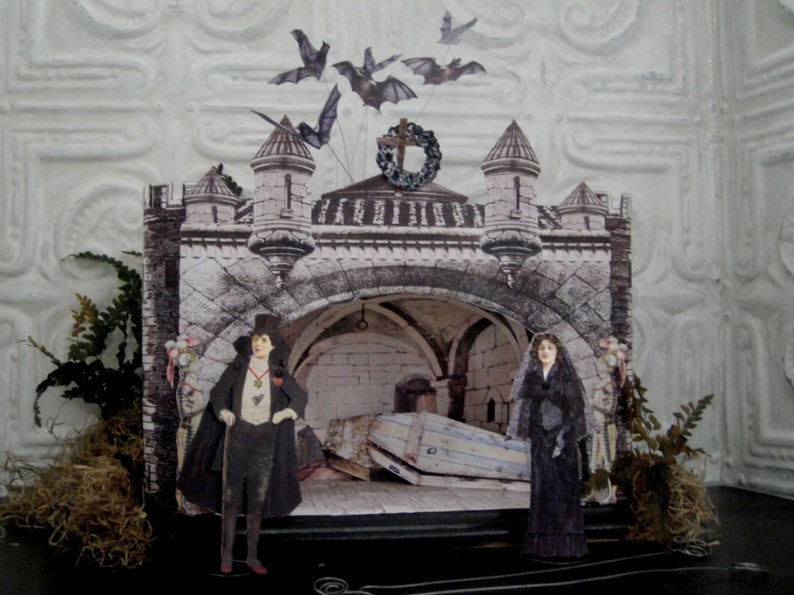FICTION
BRIEF
Make a body of work that delivers illustrations of my chosen story, adopting one of these three Deliverable Outcome Formats;
For this project I would like to use 3D illustration and photography as it is not something I have previously explored in any projects this term, I think the story I chose in particular could have a lot of potential to explore set design. I would like to explore different elements of gothic set design, gothic theatre, expressionist theatre, lighting and shadow techniques. For the final outcome I would like to create my own set design for the story, and look at different ways I can film/photograph this to reach the brief.
In the 1800s theatre diorama's were popular travelling theatres, the set would be a tunnel created from layers of painted linen, with light shone through to appear as though the scene itself was subtly moving:


Etsy artist, Altered Artifacts, creates her own miniature set designs available here:


Looking at German Expressionist Theatre and Cinema, could also provide inspiration on creating my own set design. Expressionist drama was created in Germany, requirements of the genre include: High angles, impossible sets, extreme camera tilting and deep shadows. This style made the films look as if they were almost drawn animations. One of the most famous of the time was the 1920 film The Cabinet of Dr. Caligari:

Nosferatu 1922:


German expressionist film and cinema relies heavily on the use of chiaroscuro, which means the contrasting use of light and dark in a piece of work. The technique is often used in suspence and horror films as it only allows visibility of part of the subject; for example if half a face is obscured by a shadow. It adds an eerie effect, which could be considered whilst trying to capture the genre of Gothic Horror/ Gothic Fiction into my illustrations.
Lighting tutorial on using chiaroscuro:
Shadow-play has been a popular theatre device for centuries, which is created using cutouts and puppets which are moved between a translucent or white screen and a light source to create moving shadows:


Make a body of work that delivers illustrations of my chosen story, adopting one of these three Deliverable Outcome Formats;
- 3D Illustration (Photography)
- Print Publishing/ E-Book
- Digital (Animated GIF)
CHOSEN TEXT
I have chosen to study The Tell Tale Heart, by Edgar Allen Poe, I found this to be the most enticing text. Now considered one of the pinnacles of the Gothic Fiction genre, A Tell Tale Heart has been told through a variety of media's throughout history; through film, theatre and illustration. This will provide me with a lot research material on different ways to illustrate the tale, but will leave me with the challenge of creating something original and new which illustrates the story.
INITIAL OUTCOME IDEAS
1. 3D Illustration
For this project I would like to use 3D illustration and photography as it is not something I have previously explored in any projects this term, I think the story I chose in particular could have a lot of potential to explore set design. I would like to explore different elements of gothic set design, gothic theatre, expressionist theatre, lighting and shadow techniques. For the final outcome I would like to create my own set design for the story, and look at different ways I can film/photograph this to reach the brief.
In the 1800s theatre diorama's were popular travelling theatres, the set would be a tunnel created from layers of painted linen, with light shone through to appear as though the scene itself was subtly moving:


As the brief requires us to consider the genre of the chosen text in creating an outcome, when creating a set I would have to consider how I could represent the genre of Gothic Fiction.
Edward Gorey's Dracula: A Toy Theatre:


Edward Gorey's Dracula: A Toy Theatre:


Etsy artist, Altered Artifacts, creates her own miniature set designs available here:


Looking at German Expressionist Theatre and Cinema, could also provide inspiration on creating my own set design. Expressionist drama was created in Germany, requirements of the genre include: High angles, impossible sets, extreme camera tilting and deep shadows. This style made the films look as if they were almost drawn animations. One of the most famous of the time was the 1920 film The Cabinet of Dr. Caligari:

Nosferatu 1922:


German expressionist film and cinema relies heavily on the use of chiaroscuro, which means the contrasting use of light and dark in a piece of work. The technique is often used in suspence and horror films as it only allows visibility of part of the subject; for example if half a face is obscured by a shadow. It adds an eerie effect, which could be considered whilst trying to capture the genre of Gothic Horror/ Gothic Fiction into my illustrations.
Lighting tutorial on using chiaroscuro:
Shadow-play has been a popular theatre device for centuries, which is created using cutouts and puppets which are moved between a translucent or white screen and a light source to create moving shadows:



Comments
Post a Comment